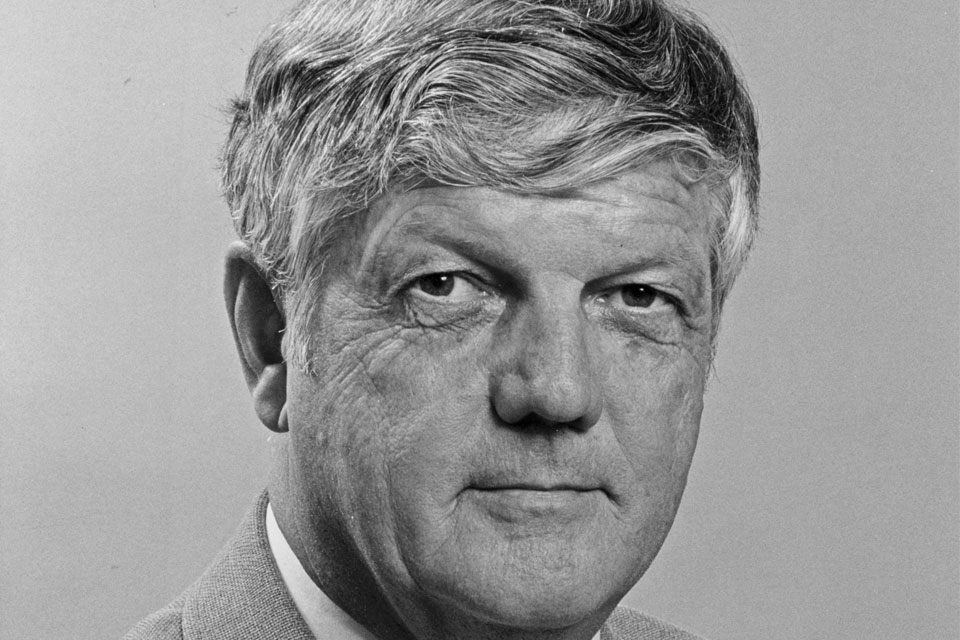Edmund (Ted) Van Brunt, MD, former director of the Kaiser Permanente Division of Research and a pioneer in the use of electronic health records in medical science, died at his home in Berkeley on May 19, 2017. He was 91 years old.
A native of Oakland and longtime Berkeley resident, Dr. Van Brunt’s medical career with Kaiser Permanente spanned 36 years, from his appointment as staff physician in the Department of Internal Medicine in Kaiser Permanente’s San Francisco medical center in 1964, to his retirement as director of the Division of Research in 1991.
“Dr. Van Brunt’s devotion to research helped build our Division into a nationally respected group,” said Tracy Lieu, MD, MPH, current director of the Division of Research. “He was revered for his steadiness and breadth of vision.”
“Ted’s leadership of the Division of Research and service as chair of the Institutional Review Board earned him great respect in Kaiser Permanente Northern California both within and outside of these units,” said Gary Friedman, MD, who succeeded Dr. Van Brunt as director of the Division of Research. “Ted was trusted by leadership to assure that our studies would contribute positively to the welfare of Kaiser Permanente and its members.”
In 1966, Dr. Van Brunt was appointed to oversee an ambitious Kaiser Permanente initiative to computerize much of its patient-related data, believed to be the first project of its kind involving medical information.
Research has been an integral part of Kaiser Permanente’s mission since its founders began providing medical care during the Great Depression and World War II.
In 1979, Dr. Van Brunt succeeded Morris F. Collen, MD, as the second director of Kaiser Permanente’s Medical Methods and Research Department; he changed the name to the Division of Research in 1986.
“Medical Methods Research didn’t really mean anything inside or outside Kaiser Permanente, while the Division of Research had an obvious meaning,” Dr. Van Brunt said in a 2001 interview. “I saw research as the face Kaiser Permanente presented to important people all over the country — in academia, government, the media, and other health care systems.”
As director of the Division of Research, Dr. Van Brunt focused on building the databases and staff needed to support a major research portfolio in epidemiology and health services. By the end of his 12-year tenure, the staff had grown from 38 to 186 people, with broad range of research interests.
Under Dr. Van Brunt’s leadership, the Division of Research:
- In 1985, launched the first clinical cycle of the Coronary Artery Risk Development in Young Adults (CARDIA) study — a contract awarded by the National Heart, Lung and Blood Institute — which has supported more than 100 ancillary studies and resulted in more than 700 publications on cardiovascular health and related topics.
- Also in 1985, founded the Kaiser Permanente Vaccine Study Center, which has led to the licensing of vaccines to prevent diseases caused by Haemophilus influenza, pneumococcus, chickenpox, meningitis, and flu.
- Pioneered research demonstrating that sigmoidoscopy screening reduced mortality from colorectal cancers; in a case-control study conducted by Division of Research investigators, the screening reduced mortality from colorectal cancer by about 60 percent, resulting in the first national recommendations for routine colorectal cancer screening.
First electronic health records
In 1961, Sidney R. Garfield, MD, Kaiser Permanente’s founding physician, sent Dr. Collen, the first Division of Research director (1961-1979), to the first national conference on computers in medicine.
In 1966, Dr. Collen appointed Dr. Van Brunt as project chief of the Medical Data System in Oakland and San Francisco, a computer-based patient medical record system with a database designed to support both patient care and health care delivery research.
At a seminal conference on medical information systems hosted by Kaiser Permanente’s Northern California region in 1970, Dr. Van Brunt wrote: “Electronic data processing management of truly large volumes of medical information has yet to be demonstrated at a level of operational sophistication that will satisfy the needs of physicians and nurses dedicated to traditional concepts of good quality medical care.”
“In addition,” he continued, “the extraordinary costs of adapting computer systems to the dynamic medical environment give rise to the question: will the costs of the new methods ultimately be less than, equal to, or greater than traditional methods?”
The objective of the Medical Data System project was to develop a multifacility, computer-based system to support the medical data requirements of one million health plan members, 1,000 physicians, and numerous professional and paramedical support staff. The system consisted of two IBM mainframe computers, and medical data from Kaiser Permanente’s multiphasic physical exam was recorded on punch cards for processing.
“The cards were put into a sorter at the end of the patient’s tour that day,” Dr. Van Brunt told a Kaiser Permanente historian in 1996. “Depending on the results, the cards would sort into ‘routine’ or ‘nonroutine’ and the patient was dealt with accordingly. That was the first application of computers.”
By 1973, members of the Kaiser Permanente Health Plan in Northern California had a computerized medical record. However, the Nixon Administration abruptly canceled federal funding of $500,000 per year, half of the project’s budget, which ultimately led to shutdown of the hospital computer system in San Francisco.
After a period of dormancy in the 1970s, Dr. Van Brunt continued to apply computers and databases in medicine and health research, supporting new investigators and new areas of research.
“The mission is to use these resources to conduct the kinds of health services research that we feel are important not just to the organization but important in a larger sense,” Dr. Van Brunt told an interviewer.
Long and varied medical career
Dr. Van Brunt graduated from UC Berkeley in 1952 with a bachelor’s degree in biophysics and obtained his medical degree from the University of California, San Francisco, in 1959. He joined the Kaiser Foundation Hospital staff as an internist the same year, was chief resident in internal medicine in 1963 and 1964, and served as a National Institutes of Health postdoctoral fellow from 1961 to 1963.
Throughout his long and varied medical career, Dr. Van Brunt continually balanced clinical, research, academic, and administrative duties. He served as physician supervisor of Kaiser Permanente’s Automated Multiphasic Health Testing Project in San Francisco in 1966 and 1967; supervised the San Francisco Medical Center’s Cardiac Pacemaker Clinic from 1974 to 1978; and taught medical information science at UC San Francisco from 1970 to 1992. Fluent in French, Dr. Van Brunt was a consultant to France’s Institute of Research in Information and Automation. In 1966, he presented a talk on the use of the automated multi-test laboratory at the first annual symposium of the Association for Advancement of Medical Instrumentation in Boston.
In addition to authoring or co-authoring more than 50 peer-reviewed journal articles, Dr. Van Brunt presented lectures and papers at dozens of symposia and medical meetings around the nation and the world. Following retirement, he served as chairman of Kaiser Permanente’s Institutional Review Board for another 20 years. He served on the editorial boards for numerous computer science and medical informatics journals, as well as the Annals of Internal Medicine and Journal of the American Medical Association.
After graduating from Berkeley High in 1944, Dr. Van Brunt served in the U.S. Army during World War II in the European Theater, returning in 1946. Dr. Van Brunt was a licensed pilot whose hobbies included piano, photography, swimming and skiing. He was predeceased in 2015 by his wife of 68 years, Claire Monod Van Brunt, and is survived by three children and four grandchildren. “Ted was a warm-hearted renaissance man,” Friedman recalled.
In an interview, Dr. Van Brunt reflected on his role in creating a modern, cutting-edge research organization within the Kaiser Permanente system: “I managed to generate some degree of respect for the organization, and how did I do that? Well, it wasn’t my charming personality. I’d point them to research already having been done and published, things of that nature, and then they gradually came around.”





This Post Has 0 Comments